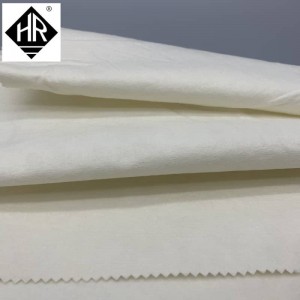The molecular structure of the antistatic agent consists of a washable part and a hydrophilic and antistatic part
[1]. In the treatment of polyester fabrics, the hydrophilic part comes from the polyether chain segment, and the washable part comes from the film formation of polyester chain segment and the whole polymer. The molecular structure of polyester chain segment is the same as that of polyester. After heat treatment, eutectic is formed and contained in the fiber, which greatly improves the washability. The longer the molecular chain segment, the larger the relative molecular weight, the better the washability. When used for plastic products, the internal adding method is used. As long as the hydrophilic base and the oilphilic base are properly combined, the antistatic additive not only maintains a certain compatibility to the plastic, but also can absorb the water in the air, and play the antistatic effect. In other words, the ions of this antistatic agent are unevenly distributed within the resin, with high surface concentration and low internal concentration, as shown in Figure 1. The antistatic action mainly depends on the monomolecular layer distributed on the resin surface. Uv protection fabric resin and antistatic additives curing together as shown in Figure 2 flame retardant fabric manufacturers
[2], the hydrophilic groups of antistatic agents are arranged towards the air side, and the water in the air is adsorbed by the hydrophilic groups to form a single molecular conductive layer. When the antistatic monomolecular layer on the surface of resin is damaged due to friction, washing and other reasons, and the antistatic performance is reduced, the antistatic agent molecules inside the resin continue to migrate to the surface, so that the surface defect of the monomolecular layer can be replaced from the inside. The length of time required for the recovery of antistatic properties depends on the migration rate of antistatic molecules in the resin and the amount of antistatic agent added, and the migration rate of antistatic agent is related to the glass transition temperature of the resin, the compatibility of antistatic agent with the resin and the relative molecular weight of antistatic agent. In fact, flame retardant fabric manufacturers chemical fiber fabrics, plastic products have a certain degree of insulation, any insulating material, its static leakage has two ways, one is the surface of the insulator, the other is the insulator inside. The former is related to surface resistance and the latter to body resistance. For plastics and fabrics, most of the static electricity leakage from the surface, experiments have proved that a similar law applies to insulators.flame retardant fabric manufacturers
[3] The action mechanism of flame retardants is complicated, but the purpose of cutting off the combustion cycle is achieved through chemical and physical ways. In the combustion of flame retardant multifunctional composite fabric plastics and chemical fiber fabrics, with the violent reaction between carbon chain and oxygen, on the one hand, the organic volatile fuel is generated, and at the same time, a large number of very active hydroxyl radical HO is generated. A chain reaction of free radicals keeps the flame burning. Antimony oxide and bromine compound flame retardant and peroxide free radical initiators promote the generation of bromine free radical under the action of heat, the generation of antimony bromide, which is a very volatile gas substance, not only can quickly absorb the emission of combustible substances, dilute the concentration of combustible substances, but also can capture HO free radicals, prevent combustion, to achieve a better flame retardant fabric effect.
Post time: Jan-03-2023

